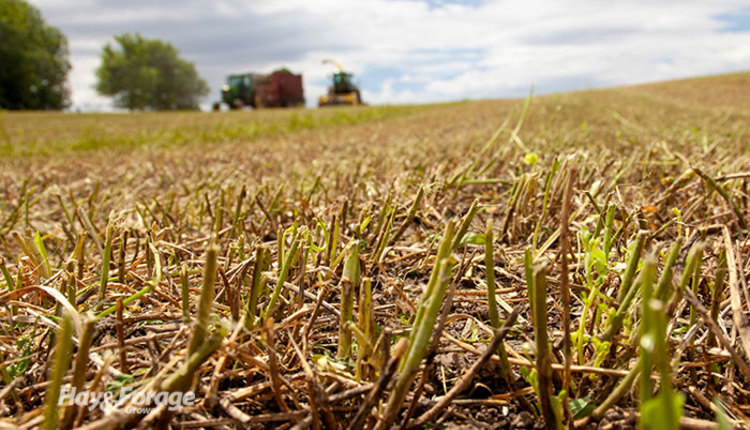Set the right cutting height |
| By Mike Rankin, Managing Editor |
|
|
 As is the case with harvest timing, cutting height makes a difference in terms of yield and persistence. But there are options and distinct differences between alfalfa and grasses. Carbohydrate reserves for regrowth are located in different plant parts, depending on the species in question. Let’s begin with alfalfa. It’s a species that stores carbohydrate reserves below ground in the taproot. This allows for a very close cutting height if so chosen. Cutting low (1 to 2 inches) results in more yield. A University of Wisconsin study showed about a 0.5 ton per acre bump in dry matter yield for each additional inch that alfalfa cutting height was lowered from 6 to 2 inches over a three-cutting season. In a follow-up study, the difference was 0.13 ton per acre per inch for first-cut alone. Though the overall quality of the forage was slightly better with the higher cutting height, the milk per acre values remained in favor of the lower cutting heights. The authors also cited the advantage (for dairy cows) of potentially lower potassium in the forage as more lower stem was harvested. Similar studies have been done in other states with similar results. Practically speaking, there is some downside to ultra-low cutting heights. On many farms, there is the issue of rough fields and rocks. Low cutting heights might translate to thrown wrenches and higher machinery repair costs. There is also the issue of ash with low cutting heights. The odds go up for an elevated ash content as the cutting height decreases, especially for coarse soils. Forage dry down may also be slower as the swath or windrow lays closer to the ground without being propped up by higher stubble. Finally, with a shorter cutting height, more axillary plant buds are removed, though these are not as important as crown buds for subsequent regrowth. In almost all cutting height studies for alfalfa, the final prognosis is to cut as low as practically possible in an effort to capture more yield. If that’s your end game, then the decision is pretty clear. However, for most alfalfa producers, the desirable approach is probably to stick with the more conventional 3-inch cutting height and avoid the previously mentioned downside factors. Grasses are different Grasses, in general, are less tolerant of ultra-low cutting heights than alfalfa. With the introduction of disc-type mowers, there have been many instances where grass or mixed forage stands have been cut out of existence because harvest heights were set too low. Although there is variability between grass species, regrowth is generated from carbohydrates stored in the lower 2 inches of stem. If routinely removed, this will impede both stand regrowth and longevity. Also, leaving some photosynthetic plant tissue aids in more rapid recovery. For most cool-season grasses such as orchardgrass or tall fescue, cutting heights need to be set at 3 to 4 inches. Cut warm-season grasses such as sorghum-sudangrass or native species at 6 to 8 inches. There are really few downsides to a higher grass cutting height. More low-quality stem is left in the field, regrowth is hastened, stand health and long-term productivity are preserved, and the risk for forage soil contamination is reduced.  Most cool-season grasses need to be cut at a minimum of 3 inches to ensure rapid regrowth and persistence.
|
